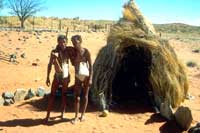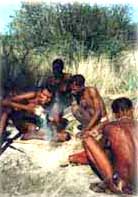Lived off the environment
The earliest hunter-gatherers in southern Africa were the San people. They mostly survived by hunting Gemsbok and other antelope and gathering plants. Hunter-gatherer societies hunt, fish and gather wild plants to survive. They also move around from place to place, following a nomadic way of life.
The invention of the bow and arrow.
The San invented their own type of bow and arrow in order to hunt effectively. They useda handbow and arrows with poisoned heads. After carefully stalking the animal whose tracks they have been following, they prepare to shoot. They shoot only once within shooting range. After hitting the animal, the narrow shaft of the arrow falls on the ground but the poisoned head remains in the wound, slowly sedating the animal. The poison penetrates through the blood system. The time needed to sedate the animal varies with the place where it was hit and the size of the animal.
It could take days of tracking before the animal collapses. Once the animal starts to weaken it can be approached. Further suffering is stopped by using spears for a final blow. This way, San can successfully hunt any animal, no matter what the size.
Note to teachers: SAHO is still developing content for this section
Social organisation
 The San built their dwellings from thin branches and long grass and could build a house in less than an hour. Source: jetzweb.de
The San built their dwellings from thin branches and long grass and could build a house in less than an hour. Source: jetzweb.de
Hunter-gatherers did not live in permanent houses, but in shelters made of materials they could find around them, like thin branches and tall grass. Women were responsible for building shelters and could do so very quickly. They never settled in the same campsite, but used the same waterholes as they moved around. This also ensured that the land did not become exhausted. The San also believed that no individual owned the land and that everybody had the right to use it. Like many groups that depend on the land for survival, they regard it as sacred and respect it as a gift of God.
The most important part of the San's lives is fire. The men are responsible for making fire and use two fire sticks that they carry with them at all times. They would rub the two sticks together until it made a spark to light some dry grass. Their lives revolved around their fire because it provided warmth, light and a way to cook food. The family would also hang their possessions in bushes close to the fire. Water was also very important in the dry Kalahari Desert and the San stored their precious liquid in the shell of an ostrich eggs under the ground where it would stay cool.
The San's clothing was very simple and made from available materials like leather from the game they caught. Children sometimes only wore beads and the men short leather pants, while women wore their karosses, or leather cloaks, made of the whole skin of an antelope.
San children were not forced to work when they were young and mostly played and copied the things their parents did. The boys would play with little bows and arrows while the girls learnt how to dig up food and carry it home, just like their mothers.
The San culture allowed for more than one wife and three or four families lived together in a group or band. This could be anything from 15 to 40 people. The band's territory is called the n!ore, which is the place that the people lived, came from and belonged.
The San had no chiefs or leaders and nobody was given special importance. A young person's first wedding was normally arranged by his or her parents. At the wedding the young man would have to bring an animal that he had killed as proof to his in-laws that he could provide for their daughter. The bride's mother would adorn her daughter with the fat of this animal and mix it with red powder to draw lines on her cheeks. The groom would then move in with the families of his wive's to serve them.
 The men are responsible for making fire and the San family gather around the fire to cook, dance and tell stories. Sources: www.africandesk.com
The men are responsible for making fire and the San family gather around the fire to cook, dance and tell stories. Sources: www.africandesk.com
Plant medicines
The San women are experts at harvesting and preparing medicinal plants for the treatment of a wide range of ailments.
San beliefs and religion
The religion of the San revolves mainly around /Kaggen; the creater of many things. He’s in many
myths portrayed as wise, foolish, tiresome or helpful. “/Kaggen” translates as “mantis” which is
why many people believe that the San worship the Preying Mantis. This is not true as /Kaggen can take on different forms, such as animals and men. Many rituals include the eland cow, because it is
believed to be /Kaggen’s favorite animal. Some rituals include the boy’s first kill, girls puberty,
marriage, and the trance dance, which was done to heal the sick. Instead of using medicine, they had a medicine man or shaman that does a trance dance to connect with the spirits to make them leave, therefore causing the illness to go away.
Rock art
San rock art is one of the great archaeological wonders of the world and it is a mirror in which reflects the glories of the African past. It is one of Southern Africa's great heritages and national treasures
They embody and reflect the rich symbolic life and world view of the San people. The art expresses the religious and spiritual beliefs of the San people.
There are approximately 15000 known rock art sites and probably twice as many as this are in existence. South Africa has one of the richest heritage's of rock art in the world.
The figure on the South African Coat of Arms comes from the Linton panel. A famous panel of rock art now housed and displayed in the South African Museum in Cape Town. In 1917, this panel was removed from the farm of Linton in the Eastern Cape.
The museum has protected the art for 83 years which has made it one of the best preserved of all pieces of South African rock art.
Our knowledge of South African San texts combined with the study of the rituals and beliefs of San people still living in the Kalahari, allows us to understand many of the paintings in the Linton panel. The panel shows people capturing a power called !Gi. The San sought this power and used it for the benefit of their community. It allowed for the healing of the sick and for the healing of divisions within society. The rock art of the San was believed to be rich in this special power.
Today we can all share the power that this delicate figure brings. Within the new Coat of Arms the figure will continue to channel its power for the benefit of all.
Note to teachers: SAHO is still developing content for this section

